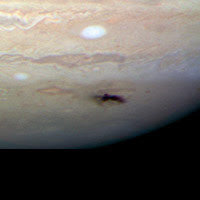Article: Something Has Hit Jupiter!
 Professional and amateur astronomers around the world are turning their telescopes toward Jupiter to monitor the dark spot that appeared around July 18/19. Although astronomers are all in agreement that something did indeed hit Jupiter, there is growing debate about whether the object was a comet or a minor planet. This debate will probably not end soon, but will hopefully be determined as more observations become available.
Professional and amateur astronomers around the world are turning their telescopes toward Jupiter to monitor the dark spot that appeared around July 18/19. Although astronomers are all in agreement that something did indeed hit Jupiter, there is growing debate about whether the object was a comet or a minor planet. This debate will probably not end soon, but will hopefully be determined as more observations become available.Although some astronomers have noted that the spot indicates a single body hit the planet, Mike Wong, a UC Berkeley researcher currently on leave at the Space Telescope Science Institute in Baltimore, points out that the complex shape of the spot indicates a cluster of objects struck the planet in the same general area.
A cluster of objects certainly is not unprecedented. It has long been known that the gravitational tidal forces surrounding the giant planet Jupiter are strong enough to shatter objects that come too close. The faint rings that surround the planet are believed to be dust from shattered objects. Crater chains exist on Jupiter's largest moons, which are believed to be the impacts of objects that broke up near the planet and then slammed into the unsuspecting moons. Of course, the best example was in 1993, when astronomers found comet Shoemaker-Levy 9 in orbit around Jupiter. It was quickly noted that about one year earlier, the comet had passed within the danger zone of Jupiter, which resulted in it breaking into 21 pieces. Each of these pieces then slammed into Jupiter during July 1994.
Observations made during the last few days are showing the new spot has become elongated, which is due to the fact that Jupiter's clouds circle the planet at different speeds, depending on the latitude. This elongating has now made the spot about the width of the Pacific Ocean.
The Gemini North telescope has become the latest large telescope on Mauna Kea (Hawaii) to image the comet. Since the images were obtained in the infrared range, the spot appears as the brightest feature on the planet, instead of the darkest feature, because of the residual heat from the impact.
Another large telescope has been called into service because of the dark spot. Back in May, the Hubble Space Telescope had new equipment installed during a space shuttle mission. Although the complex task of calibrating the new equipment is not yet complete, this event was deemed important enough to bring the Hubble back on line. The resulting image illustrates this article and it is the most detailed image yet. More Hubble images will be obtained in the coming weeks.
Comments